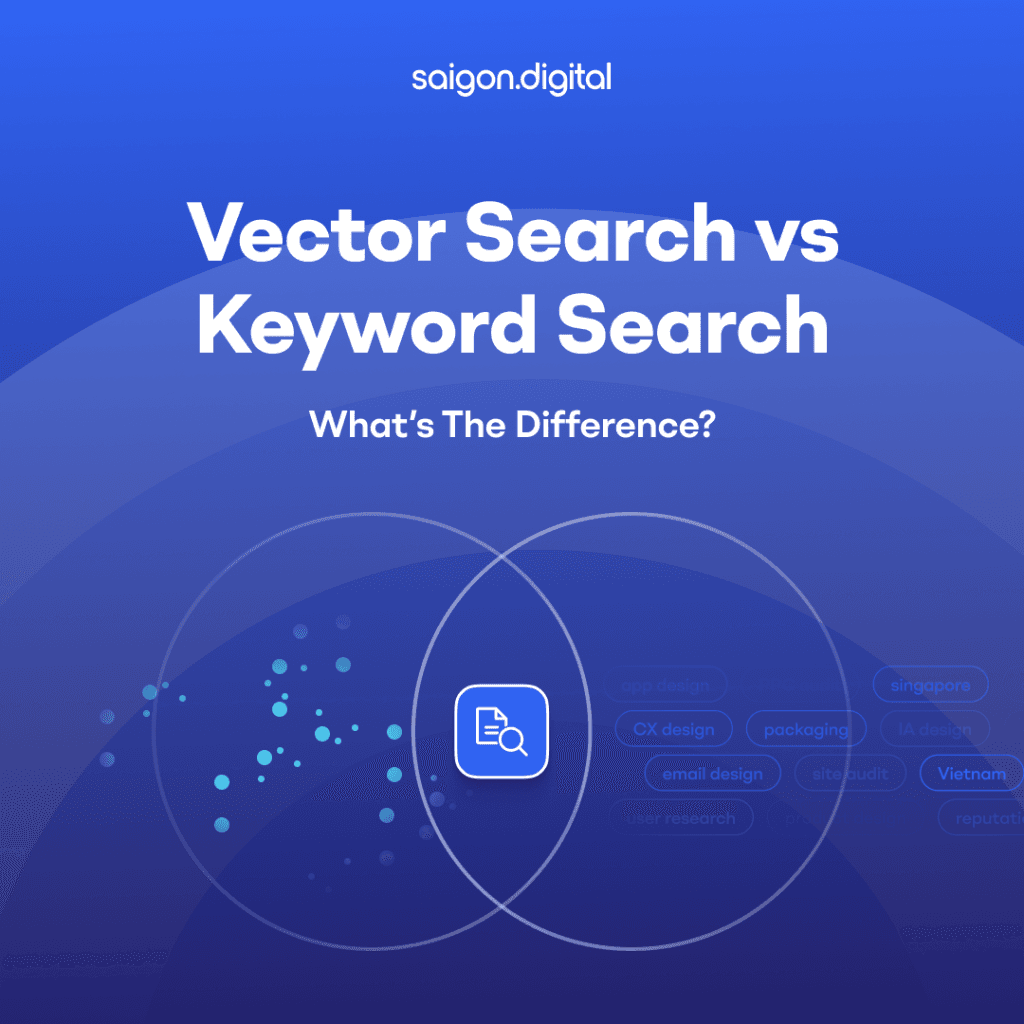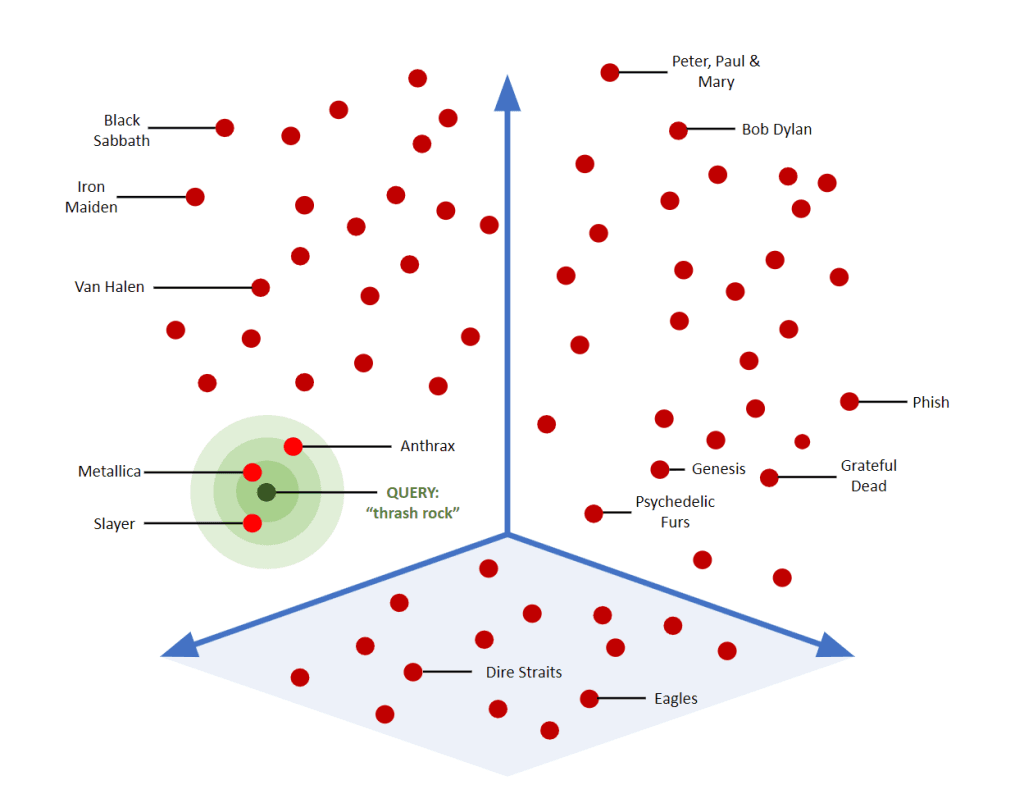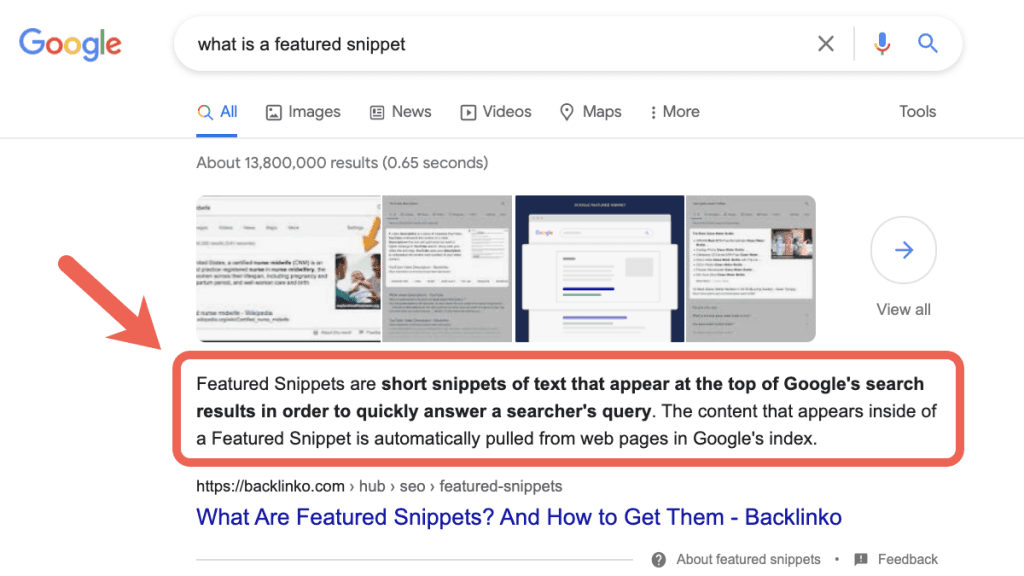
What Is Keyword Search?
Keyword search is the traditional backbone of most search engines, relying on matching the words in a user’s query with the same or similar words in a document. It’s fast and reliable. However, while effective for precision, it often struggles to grasp meaning or search intent . To understand why, let’s take a closer look at how keyword search works in practice and where its strengths and weaknesses lie.The Basics and Mechanics
Keyword search (sometimes called lexical search or full-text search) is probably what you imagine when thinking of a “search box.” A user enters words or phrases (keywords), and the search engine retrieves documents containing those words (or close variants). The engine often uses an inverted index under the hood: a mapping of each term to the documents in which it appears. It might also apply ranking models like TF-IDF or BM25 to score how well documents match the query. To refine matching, keyword search systems often use:Stemming and Lemmatisation
These processes reduce words to their base or “root” form so that different variations of the same word are recognised as related. For instance, “run,” “running,” and “ran” are all mapped to a common base form (“run”). This ensures that a search for “running shoes” can still return a page using the word “ran,” improving coverage without requiring manual synonym entries.
Synonym Dictionaries or Thesauri
To overcome the limitations of exact word matching, many systems use synonym lists that link related terms together. For example, “car” and “automobile” might be treated as equivalents, allowing users searching for either term to see relevant results. However, this relies on the search administrator maintaining a well-curated list, which can become cumbersome over time, especially for specialised industries or evolving vocabularies.Boolean Logic, Phrase Matching, and Proximity Constraints
Keyword search engines allow users to refine queries using logical operators such as AND, OR, and NOT. For example, “coffee AND sustainability” ensures both terms must appear, whereas “coffee OR tea” widens the scope. Phrase matching (using quotation marks, e.g. “best running shoes”) forces the engine to find the exact phrase, while proximity constraints ensure certain words appear near each other. These tools give users and SEO specialists fine-grained control over how search results are filtered.Fuzzy Matching and Edit Distance
Let’s face it, people often make typos when either texting or searching. But the good thing is, fuzzy matching algorithms help address that. Fuzzy matching calculates how similar two words are based on the number of edits (insertions, deletions, substitutions) needed to turn one into the other. For example, “environmet” could still match “environment” even though it’s misspelled. This helps capture queries with small errors, improving user experience and keeping search results relevant.Strengths and Limitations
Because keyword search is well established and has been implemented ever since search engine becomes a thing, it is no surprise that it has many advantages:- Speed and efficiency: it is computationally light (for many use cases), especially for exact matches or small to medium datasets
- Deterministic control: you can precisely control which documents match or don’t (via Boolean filters, boosts, etc.)
- Maturity and tooling: many search engines (Elasticsearch, Solr, Postgres full-text search) have mature support and optimisations
- Good for structured, exact queries: e.g. “model number 1234” or “site:example.com inurl:pdf”
- Poor handling of semantics and meaning: it struggles with synonyms, context, or user intent. For example, “interest rate” vs “borrowing cost” may not match well.
- Ambiguity issues: a query like “java” could refer to the programming language, the island, or coffee; keyword systems may return a mix unless refined
- Long tail and rare queries: if the user phrased something in an unusual way, there might be no exact match
- Maintenance burden: keeping synonym lists, managing edge cases, handling new vocabulary can be laborious
- Scaling semantic enrichment is hard: as you try to inject more “understanding,” complexity rises
What Is Vector Search?
Vector search represents a new generation of search technology that moves beyond exact word matching to understand meaning and context. Instead of focusing on specific keywords, it interprets the intent behind a query by analysing the relationships between words, concepts, and ideas. To see how this works in practice, let’s explore the core mechanics of vector search and the advantages and challenges it introduces.Concept and Mechanism
Vector search (sometimes called semantic search, embedding search, or similarity search) takes a different approach. Instead of directly matching keywords, it transforms queries and documents into high-dimensional numerical vectors (embeddings) via machine learning models. These embeddings capture semantic meaning: similar ideas tend to map to vectors close together in this high-dimensional space. Once both query and documents are embedded, the search process reduces to finding nearest neighbours (vectors closest in distance or angle). Common similarity metrics include cosine similarity or Euclidean (L2) distance. For speed, we often use Approximate Nearest Neighbour (ANN) methods (e.g. FAISS, HNSW) rather than brute force. Here is a simple illustrative example:- Document A: “Tips for jogging shoes and foot comfort” → becomes vector vA
- Document B: “Guide to basketball sneakers” → becomes vector vB
- Document C: “Running gear for marathoners” → vector vC

Advantages and Trade-offs
Vector search offers powerful advantages:- Semantic matching and synonyms: it naturally handles synonyms, related phrases, and user intent
- Contextual understanding: it can disambiguate queries based on context
- Better for long queries / questions: if a user types a natural language question (“How do I choose running shoes for flat feet?”), vector search handles nuance better
- Robust to variation: slight phrasing changes or reordered words tend not to break the result
- Multimodal and cross-modal support: you can embed text, images, audio etc. into the same vector space and query across modalities
- Computational cost: embedding and nearest-neighbour search at scale require significant resources
- Complex implementation: you need to choose embedding models, indexing methods, and tune them
- Less precise control over exact matching: vector methods may miss exact constraints (for example, precise keyword filtering, Boolean logic)
- Cold start and domain specificity: the embedding model might not represent very niche or new domain language well
- Interpretability issues: it's harder to explain why a result was ranked (black box)
Side-by-Side Comparison and Practical Examples
To crystallise the differences, let’s look at a comparative table and then walk through a few scenarios. Dimension Keyword Search Vector Search Matching method Exact or fuzzy matching of terms Semantic similarity in vector space Strength Precise control, fast for well defined queries Captures meaning, handles synonyms and context Interpretation Transparent (you see matched terms) Opaque (“why this?” is less obvious) Speed (simple queries) Very fast Slower, though ANN helps Scalability for semantics Hard to scale synonyms, context Scales better for semantic coverage Use case fit Structured filters, exact matches Question answering, recommendations, long-tail queries Complexity Lower Higher — needs ML / embeddings / indexingExample 1: Synonym query
Keyword search: Query “car repair” may miss documents labelled “automobile maintenance” unless a synonym mapping exists. Vector search: Embeddings capture the similarity between “car” and “automobile,” surfacing relevant content without manual synonym lists.Example 2: Ambiguous query
Keyword search: A search for “python tutorial” may also return pages for “python snake” unless filters are applied. Vector search: The embedding of “python tutorial” (from a programming context) is likely closer to programming materials, so less noise about snakes.Example 3: Rare phrasing
Keyword search: A user types “footwear for runners with wide feet” — if your pages use “wide running shoes,” maybe you match, but if your page says “broad jogging gunters,” you might miss it. Vector search: The meaning of “wide feet” and “broad” and “running shoes” may cluster, enabling a match on concept over exact phrasing.Hybrid / Blended approach
It’s common today to combine keyword search and vector search into a hybrid system. For instance:- Use keyword search to filter (e.g. restrict to “shoes” category or price range)
- Use vector search to rank candidates by semantic relevance
- Merge or re-rank results from both methods, giving weight as needed
Vector Search vs Keyword Search in the SEO World
Having reviewed what they are and how they differ, let’s now examine how these search methods relate to SEO and your strategy as a content owner or digital marketer.Why SEO Still Cares About “Vector Search vs Keyword Search”
Search engines like Google have long relied on keyword matching (in combination with many other signals). But today they increasingly incorporate semantic understanding, embeddings, and AI-powered components (for example, RankBrain, BERT, MUM). This means that even though you might craft content via keyword research strategies, search engines are moving toward evaluating meaning, entities, context, aligning more with “vector-like” understanding than pure keywords. Thus, content that only matches precise keywords might perform less well when search engines can infer user intent, synonyms, or related topics.Implications and Actionable Guidance
Here are actionable ideas and considerations (from our perspective at Saigon Digital) when you think about SEO in light of “vector search vs keyword search”:1. Focus less on exact keyword phrases, more on topics and entities
Modern search engines increasingly interpret meaning rather than counting keywords. This means content that naturally explains a topic in depth will often perform better than content that rigidly repeats specific phrases. When planning content, think in terms of topics, concepts, and entities . For example, write a complete guide about “sustainable fashion” rather than narrowly targeting the phrase “eco-friendly clothing.” This broader coverage signals to search engines that your page understands the subject, making it more relevant to varied user intents.2. Use semantic content clusters
Structuring your website around interconnected content topics helps search engines understand relationships between ideas. By linking related articles (for example, “vegan diets,” “plant-based recipes,” and “nutrition for athletes”), you build a web of meaning that reinforces authority in your niche. This approach not only improves internal linking and user navigation but also aligns with how vector-based algorithms evaluate context and topic depth.3. Optimise for question and long-tail queries
As users increasingly search using natural language, queries have become longer and more conversational, like “how do I improve my site’s local ranking?” rather than just “ local SEO. ” By including FAQs, clear subheadings, and conversational phrasing in your content, you cater to these longer, intent-rich searches. Vector search systems are designed to interpret such queries effectively, so covering them helps your content surface across a broader range of search contexts.4. Avoid over-optimisation for odd, rare keywords
In the past, SEO often involved targeting unusual or awkward keyword phrases to capture specific traffic. Today, that approach feels unnatural and can harm readability and user trust. Since vector search understands meaning rather than just words, it’s far better to write naturally and focus on clarity. Instead of forcing a phrase like “ best marketing agency Ho Chi Minh ,” use smooth, human language that accurately conveys intent, the algorithms will recognise the relevance.5. Use structured data and entity markup
While vector search relies heavily on meaning, structured data still plays a vital supporting role. Marking up your pages with Schema.org helps search engines identify entities, such as organisations, products, reviews, or events, with precision. This added structure reinforces context, helping both traditional and semantic algorithms interpret your content correctly and improving your chances of enhanced search visibility, such as featured snippets or rich results.
6. Monitor semantic shifts via analytics and content performance
Search behaviour changes over time, as do the ways people describe their needs. By regularly reviewing your analytics data and query reports, you can identify emerging terms or shifts in language. Use these insights to refresh existing content, add new related topics, or adjust your messaging. This ongoing optimisation ensures your content continues to align with both user intent and evolving search algorithms.7. Prepare for “Answer Engine Optimisation” (AEO)
As search moves toward AI-driven answers, such as Google’s AI Overviews or other conversational search tools, the ability to provide clear, concise, and authoritative answers is increasingly valuable. Structuring your content so that key points, definitions, and takeaways are easy to extract will help AI systems reference your material directly. Think of AEO as the natural evolution of SEO in a world dominated by semantic and vector-based search.8. Hybrid thinking in internal site search and on-site search
Beyond public SEO, consider how your own website’s search function operates. Combining keyword search for precision (like filtering by brand or category) with vector search for understanding (matching intent and context) can dramatically improve user experience. A well-optimised on-site search not only helps users find content more easily but also signals to search engines that your site is well-structured and engaging, reducing bounce rates and improving conversions.9. Test and iterate with embeddings and semantic tools
Transitioning toward vector search doesn’t have to be overwhelming. Start small by experimenting with embedding models or semantic keyword tools to analyse your existing content. Compare how these models interpret your topics and see if they align with what users expect. Gradual testing and refinement help you make informed, data-driven improvements, allowing your site to evolve naturally as search technology advances.Example: How This Might Play Out for a Content Page
Imagine you run a blog about nutrition. You have an article titled “Best foods for brain health” . You optimise it for “brain health foods,” “foods good for cognition,” and “nutrients for brain function.” That covers a few keyword variants. Now, because modern search engines use embeddings and semantic models, queries like “what to eat to improve memory” or “foods that boost mental capacity” may map close to your content’s embedding. Because your content already covers related subtopics (omega-3, antioxidants, etc.), search engines can see semantic alignment and may surface your page—even if your exact phrase wasn’t used. This increases the potential reach of your content to “vector-style” queries. If instead your content only rigidly repeated the exact phrase “brain health foods” many times without covering subtopics or natural language variations, it might more narrowly rank for that exact phrase but lose out on broader relevant traffic.When to Use Which Or Both
From a practical standpoint (and from our experience at Saigon Digital), “vector search vs keyword search” isn’t about picking one forever. It’s about knowing the right tool for the job or combining both.- Use keyword search when you require filters, exact matches, structured constraints (e.g. product SKUs, categories, Boolean logic).
- Use vector search when user intent, meaning, nuance, or long-form queries matter (e.g. emotion, concept discovery, question answering).
- Use a hybrid approach whenever possible, blending keyword filters + semantic ranking.
- Prototype a vector embedding for your content (e.g. use open models)
- Query the embedding space and see how well results match user expectations
- Merge with existing keyword matches, and A/B test the combined system
- Monitor metrics (clicks, bounce, user satisfaction) and refine





